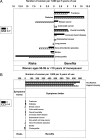Postmenopausal hormone therapy: an Endocrine Society scientific statement
- PMID: 20566620
- PMCID: PMC6287288
- DOI: 10.1210/jc.2009-2509
Postmenopausal hormone therapy: an Endocrine Society scientific statement
Abstract
Objective: Our objective was to provide a scholarly review of the published literature on menopausal hormonal therapy (MHT), make scientifically valid assessments of the available data, and grade the level of evidence available for each clinically important endpoint. PARTICIPANTS IN DEVELOPMENT OF SCIENTIFIC STATEMENT: The 12-member Scientific Statement Task Force of The Endocrine Society selected the leader of the statement development group (R.J.S.) and suggested experts with expertise in specific areas. In conjunction with the Task Force, lead authors (n = 25) and peer reviewers (n = 14) for each specific topic were selected. All discussions regarding content and grading of evidence occurred via teleconference or electronic and written correspondence. No funding was provided to any expert or peer reviewer, and all participants volunteered their time to prepare this Scientific Statement.
Evidence: Each expert conducted extensive literature searches of case control, cohort, and randomized controlled trials as well as meta-analyses, Cochrane reviews, and Position Statements from other professional societies in order to compile and evaluate available evidence. No unpublished data were used to draw conclusions from the evidence.
Consensus process: A consensus was reached after several iterations. Each topic was considered separately, and a consensus was achieved as to content to be included and conclusions reached between the primary author and the peer reviewer specific to that topic. In a separate iteration, the quality of evidence was judged using the GRADE (Grading of Recommendations, Assessment, Development, and Evaluation) system in common use by The Endocrine Society for preparing clinical guidelines. The final iteration involved responses to four levels of additional review: 1) general comments offered by each of the 25 authors; 2) comments of the individual Task Force members; 3) critiques by the reviewers of the Journal of Clinical Endocrinology & Metabolism; and 4) suggestions offered by the Council and members of The Endocrine Society. The lead author compiled each individual topic into a coherent document and finalized the content for the final Statement. The writing process was analogous to preparation of a multiauthored textbook with input from individual authors and the textbook editors.
Conclusions: The major conclusions related to the overall benefits and risks of MHT expressed as the number of women per 1000 taking MHT for 5 yr who would experience benefit or harm. Primary areas of benefit included relief of hot flashes and symptoms of urogenital atrophy and prevention of fractures and diabetes. Risks included venothrombotic episodes, stroke, and cholecystitis. In the subgroup of women starting MHT between ages 50 and 59 or less than 10 yr after onset of menopause, congruent trends suggested additional benefit including reduction of overall mortality and coronary artery disease. In this subgroup, estrogen plus some progestogens increased the risk of breast cancer, whereas estrogen alone did not. Beneficial effects on colorectal and endometrial cancer and harmful effects on ovarian cancer occurred but affected only a small number of women. Data from the various Women's Health Initiative studies, which involved women of average age 63, cannot be appropriately applied to calculate risks and benefits of MHT in women starting shortly after menopause. At the present time, assessments of benefit and risk in these younger women are based on lower levels of evidence.
Figures





References
-
- Swiglo BA, Murad MH, Schünemann HJ, Kunz R, Vigersky RA, Guyatt GH, Montori VM. 2008. A case for clarity, consistency, and helpfulness: state-of-the-art clinical practice guidelines in endocrinology using the grading of recommendations, assessment, development, and evaluation system. J Clin Endocrinol Metab 93:666–673 - PubMed
-
- Mendelsohn ME, Karas RH. 2005. Molecular and cellular basis of cardiovascular gender differences. Science 308:1583–1587 - PubMed
-
- Mendelsohn ME, Karas RH. 1999. The protective effects of estrogen on the cardiovascular system. N Engl J Med 340:1801–1811 - PubMed
-
- Grady D, Rubin SM, Petitti DB, Fox CS, Black D, Ettinger B, Ernster VL, Cummings SR. 1992. Hormone therapy to prevent disease and prolong life in postmenopausal women. Ann Intern Med 117:1016–1037 - PubMed
-
- Rossouw JE, Prentice RL, Manson JE, Wu L, Barad D, Barnabei VM, Ko M, LaCroix AZ, Margolis KL, Stefanick ML. 2007. Postmenopausal hormone therapy and risk of cardiovascular disease by age and years since menopause. JAMA [Erratum (2008) 299:1426] 297:1465–1477 - PubMed
Publication types
MeSH terms
Grants and funding
LinkOut - more resources
Full Text Sources
Other Literature Sources
Medical
Research Materials

